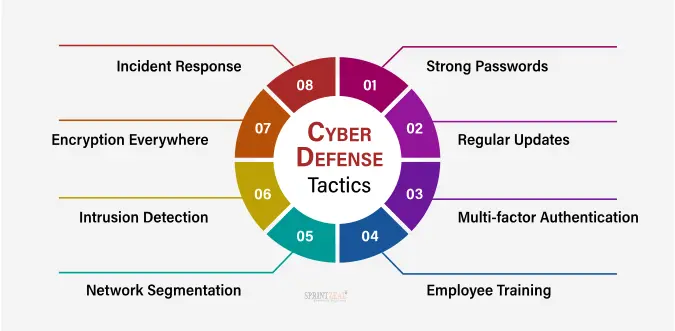Preventing cyberattacks requires a proactive and multi-layered approach that encompasses both technical solutions and user awareness. Here are some effective strategies to help prevent cyberattacks:
- Keep Software Updated: Regularly update operating systems, software applications, and firmware to patch known vulnerabilities and mitigate the risk of exploitation by cyber attackers.
- Use Strong Authentication: Enforce the use of strong, unique passwords and implement multi-factor authentication (MFA) wherever possible to add an extra layer of security.
- Employ Firewalls and Security Software: Deploy firewalls, antivirus software, anti-malware tools, and intrusion detection/prevention systems to monitor and filter network traffic, detect threats, and prevent unauthorized access.
- Encrypt Data: Encrypt sensitive data both in transit and at rest to protect it from unauthorized access or interception. Encryption ensures data confidentiality and privacy by scrambling information so that it can only be read by authorized parties.
- Backup Data Regularly: Regularly back up critical data and ensure that backups are stored securely offline or in a separate, isolated network. This helps ensure data availability and recoverability in the event of a cyberattack or data loss incident.
- Implement Least Privilege Access: Grant users access only to the resources and information necessary for their roles (i.e., least privilege). Limiting access helps minimize the potential damage caused by compromised accounts.
- Train Employees on Cybersecurity Awareness: Educate employees about common cyber threats, phishing scams, and best practices for maintaining security. Provide regular training sessions and simulated phishing exercises to test their awareness and response.
- Secure Mobile Devices: Implement mobile device management (MDM) solutions to enforce security policies, remotely wipe lost or stolen devices, and ensure that mobile devices are protected with strong passcodes or biometric authentication.
- Monitor Network Activity: Continuously monitor network traffic, logs, and system activity for signs of suspicious behavior or potential security incidents. Implement security information and event management (SIEM) solutions to detect and respond to threats in real-time.
- Establish Incident Response Plans: Develop and regularly test incident response plans to ensure a swift and effective response to security incidents. Define roles and responsibilities, establish communication channels, and outline steps for containing, investigating, and mitigating cyberattacks.
By implementing these preventive measures and fostering a culture of cybersecurity awareness within your organization, you can significantly reduce the risk of cyberattacks and protect your valuable digital assets from cyber threats. Remember that cybersecurity is an ongoing process that requires vigilance, collaboration, and continuous improvement to stay ahead of evolving threats.
